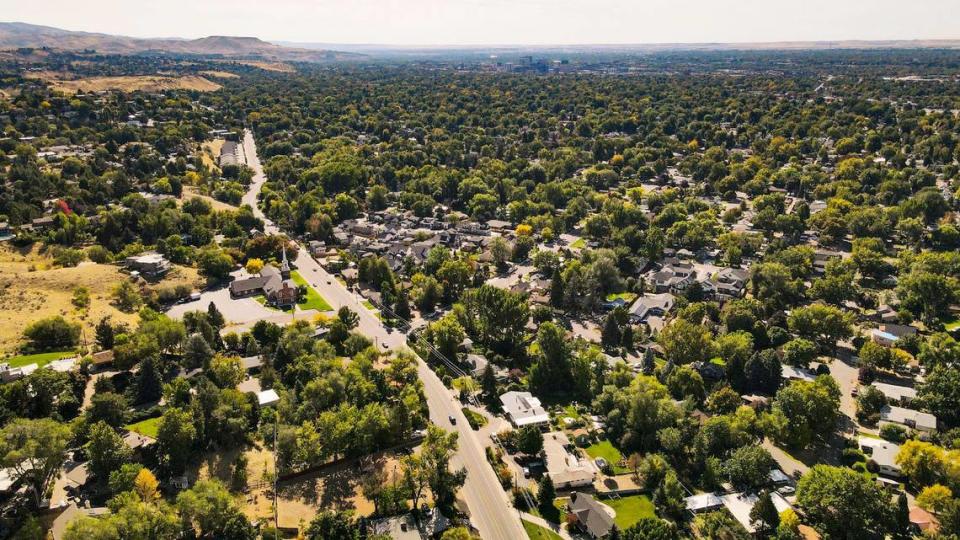Suffering from allergies in Boise? It’s not just high pollen count that can make you sneeze
When Benjamin Bonneville first spotted the mass of cottonwood trees surrounding a river, and exclaimed, “Les Bois! Les Bois!” — French for “The woods!” — he was right about one thing: Many trees were spread across the valley below him. Although the story can’t be confirmed by the Idaho State Historical Society, the society does believe it’s a plausible reason for the city being named Boise.
The story of Bonneville is also why Boise is nicknamed the City of Trees. With so many trees, the spring can only mean one thing: severe allergies.
The worst spring allergies in the United States occur on the east side of the country, according to a study by the Asthma and Allergy Foundation of America. But Boise helps carry the allergy banner for the western U.S. The City of Trees is the fourth-highest-ranked city west of the Rocky Mountains for worst allergies, trailing only Las Vegas (31st), Tucson, Arizona (43rd), and Riverside, California (49th).
While most people are familiar with typical allergy symptoms — including symptoms like a runny nose, itchy eyes and a scratchy throat — there are also some lesser-known facts regarding allergies.
The Idaho Statesman talked to Boise CVS Pharmacy district manager Jessica Chenoweth to find out more.

Boise spring allergies
Discerning between allergies and a cold
Although there tends to be a line in the sand between a winter cold and spring allergies, it can be quite blurry. Spring is the second-most-likely season to catch a cold, according to St. Luke’s, and there are ways to tell the difference.
While colds and allergies can involve congestion and other head-cold symptoms, the most significant difference is the color of the nasal drip.
“Usually, that nasal drip is clear, which is very specific to allergies,” Chenoweth said. “A cold will sometimes be accompanied by a fever, and you may have phlegm of a yellow or green color, which are differentiated.”
Allergies can be late onset
Just because someone didn’t suffer allergies as a kid doesn’t mean they can’t later in life. Depending on where a person is health-wise and the condition of their immune system, they can experience variations throughout their life in their susceptibility to allergies.
“Individuals that have comorbidities, so something like hypertension, diabetes, cancer, people that are immunosuppressed, are going to have a different immune response than a healthy individual,” Chenoweth said.
It’s not always the pollen causing allergies
Tree, grass and weed pollen are the most common causes of seasonal allergies. According to the study by AAFA, tree pollen is the first to appear each year and is primarily responsible for allergies between February and June.
But sometimes, the reason for allergies is a little closer to home.
“People that are maybe around animals that they’re not typically around can oftentimes experience an allergic response to that animal,” Chenoweth said.
She also said that combining animal allergens with pollen allergens can result in more severe symptoms, such as facial pain from nasal congestion, chest tightness and skin rashes or hives.
Alcohol can make symptoms worse
Alcohol doesn’t necessarily cause an allergic reaction, but it can interact with the body’s immune system and make a person more susceptible to lower levels of allergens.
According to Pinnacle ENT, an ear, nose and throat, allergy and audiology practice, the manufacturing process of alcohol can even result in an allergic reaction. For example, alcohol aged in a wooden barrel can cause a reaction in people with tree nut sensitivity.
Alleviating allergy symptoms
Over-the-counter pharmaceutical remedies like oral antihistamines and nasal sprays can help alleviate allergy symptoms, but lifestyle changes can also help.
“Avoid being outside on the days that pollen counts are really high,” Chenoweth said. “Changing your clothes after you’re outside, making sure that we’re leaving our shoes in a garage or outside and not tracking that pollen into our homes.”
Cottonwood trees are producing the most pollen right now in Boise, according to the Boise Valley Asthma and Allergy Clinic, but birch and maple trees and grass are also producing pollen.
Chenoweth also recommended using an air purifier, vacuuming and dusting your household more frequently. She also said people can contact their local pharmacist to help alleviate symptoms.
“People can absolutely feel comfortable consulting their local pharmacist for their allergy needs,” Chenoweth said. “Pharmacists are a wealth of knowledge and are always happy to help provide guidance as someone walks through that allergy aisle in a pharmacy.”

